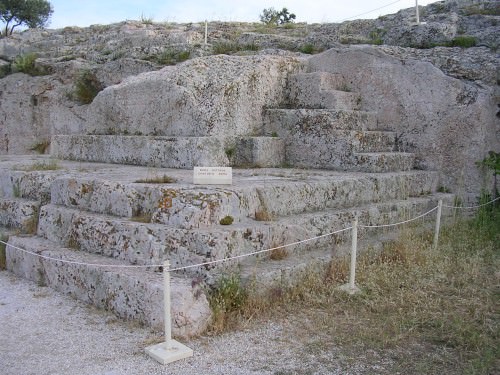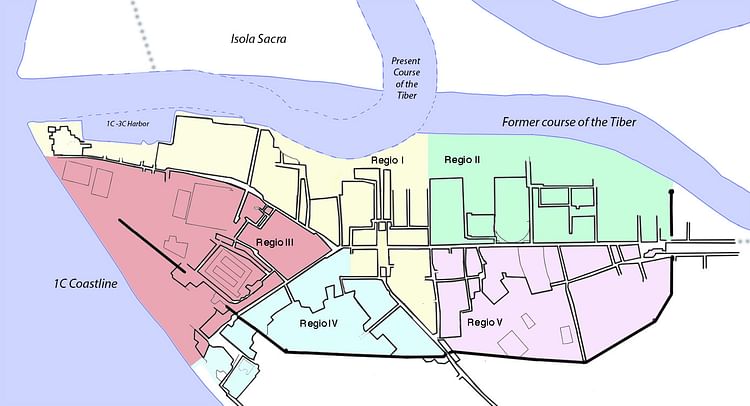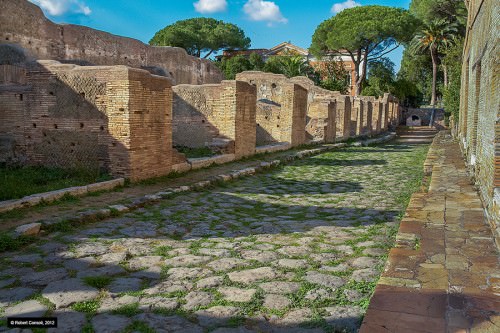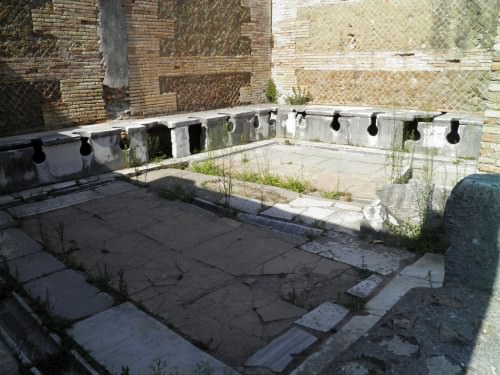Ancient Greek Government › Ostia » Ancient origins
Articles and Definitions › Contents
- Ancient Greek Government › Antique Origins
- Ostia › Ancient History
Ancient civilizations › Historical and archaeological sites
Ancient Greek Government › Antique Origins
Definition and Origins

The government systems of ancient Greece were varied as the Greeks searched for the answers to such fundamental questions as who should rule and how? Should sovereignty ( kyrion ) lie in the rule of law ( nomoi ), the constitution ( politea ), officials, or the citizens? Not settling on a definitive answer to these questions, government in the ancient Greek world, therefore, took extraordinarily diverse forms and, across different city -states and over many centuries, political power could rest in the hands of a single individual, an elite or in every male citizen: democracy - widely regarded as the Greeks' greatest contribution to civilization.
The four most common systems of Greek government were:
- Democracy - rule by the people (male citizens).
- Monarchy - rule by an individual who had inherited his role.
- Oligarchy - rule by a select group of individuals.
- Tyranny - rule by an individual who had seized power by unconstitutional means.
Our knowledge of the political systems in the ancient Greek world comes from a wide range of sources. Whilst for Athens, it is possible to piece together a more complete history, we have only an incomplete picture of the systems in most city-states and many details of how the political apparatus actually functioned are missing. Surviving, though, are over 150 political speeches and 20,000 inscriptions which include 500 decrees and 10 laws. There are also two specifically political texts with the same title, The Constitution of the Athenians, one written by Aristotle or one of his pupils and the other attributed (by some) to Xenophon. Other sources which discuss politics and government include Aristotle's Politics and the historical works of Herodotus, Thucydides, and Xenophon. In addition, politics is often lampooned in the comedies of Aristophanes.
DEMOCRACY
Athens' constitution is called a democracy because it respects the interests not of the minority but of the whole people. When it is a question of settling private disputes, everyone is equal before the law; when it is a question of putting one person before another in positions of public responsibility, what counts is not membership of a particular class, but the actual ability which the man possesses. ( Pericles, 431 BCE)
ANY MALE CITIZEN 18 YEARS OR OVER COULD SPEAK (AT LEAST IN THEORY) & VOTE IN THE ASSEMBLY OF ATHENS.
The word democracy derives from the Greek dēmos which referred to the entire citizen body and although it is Athens which has become associated with the birth of democracy ( demokratia ) from around 460 BCE, other Greek states did establish a similar political system, notably, Argos, (briefly) Syracuse, Rhodes, and Erythrai. Athens is, however, the state we know most about. The assembly of Athens met at least once a month, perhaps two or three times, on the Pnyx hill in a dedicated space which could accommodate 6000 citizens. Any male citizen 18 years or over could speak (at least in theory) and vote in the assembly, usually with a simple show of hands. Attendance was even paid for in certain periods which was a measure to encourage citizens who lived far away and couldn't afford the time-off to attend.

Speaker's Platform, Athens Assembly, Pynx, Athens
Citizens probably accounted for 10-20% of the polis population, and of these it has been estimated that only 3,000 or so people actively participated in politics. Of this group, perhaps as few as 100 citizens - the wealthiest, most influential, and the best speakers - dominated the political arena both in front of the assembly and behind the scenes in private conspiratorial political meetings ( xynomosiai ) and groups ( hetaireiai ). Critics of democracy, such as Thucydides and Aristophanes, also pointed out that the dēmos could be too easily swayed by a good orator or popular leaders (the demagogues) and get carried away with their emotions. Perhaps the most famous bad decision from the Athenian democracy was the death sentence given to the philosopher Socrates in 399 BCE.
Issues discussed in the assembly ranged from deciding magistracies to organising and maintaining food supplies to debating military matters. There was in Athens (and also Elis, Tegea, and Thasos) a smaller body, the boulē, which decided or prioritised the topics which were discussed in the assembly. In addition, in times of crisis and war, this body could also take decisions without the assembly meeting. The boulē or council of 500 citizens was chosen by lot and had a limited term of office, which acted as a kind of executive committee of the assembly. The decrees of the Assembly could also be challenged by the law courts. Similar in function to the boulē was the council of elders (selected men over 60), the gerousia, of Sparta, which also had the two Spartan kings as members and had certain legal powers. Similar bodies of elders existed in Corinthand Stymphalos. In Athens, the Areopagus was a similar such council, where elders were made members for life.

Socrates
In other Greek states then, there were also democratic assemblies, sometimes, though, with a minimum property stipulation for attendees (as in the Boiotian federation 447-386 BCE). Some city-states also mixed democratic assemblies with a monarchy (for example, Macedonia and Molossia).
THE KINGS OF SPARTA WERE KEPT IN CHECK BY EPHORS (EPHOROI) WHO WERE THEMSELVES ELECTED BY THE ASSEMBLY.
MONARCHY
In the Greek world monarchies were rare and were often only distinguishable from a tyranny when the hereditary ruler was more benevolent and ruled in the genuine interest of his people. The most famous monarchies were those in the states of Macedonia and Epeiros, where the ruler shared power with an assembly, limited though these were in practice. Although Sparta also possessed a citizen assembly, it is most famous for its system of two kings. Not absolute monarchs, they did, however, hold great power when they led the Spartan army in times of war. During peacetime the kings were kept in check by ephors ( ephoroi ) who were themselves elected by the assembly. Clearly, a degree of political consensus was necessary for this overlapping apparatus to function. The kings were also members of the gerousia and were admitted from a young age, so that they must have had a significant advantage over the other members who couldn't join until they were 60. Spartan kings could, however, be put on trial and even exiled.
TYRANNY
Tyrants were sole rulers of a state who had taken power in an unconstitutional manner, often murdering their predecessor.However, Greek tyrants were not necessarily evil rulers (as the word signifies today); they simply looked after their own interests. Syracuse in Sicily had a run of famous tyrants, for example, Dionysios from 405 BCE and his son Dionysios II, who took over in 367 BCE. Others include Pesisistratos in Athens (from c. 560 BCE) - a typical benevolent tyrant who actually paved the way for democracy, Pheidon in Argos (c. 660 BCE), Lykophron in Thessaly, the Kypselidai, which included Periander, in Corinth (c. 657-585 BCE), and Polykrates in Samos (530-522 BCE). For Athenians, tyranny became the exact opposite of democracy, a position that allowed the citizens of Athens to feel a certain superiority. This feeling was especially evidenced in the demonizing of the Persian kings Darius and Xerxes, the tyrants par excellence.

Periander
OLIGARCHY
An oligarchy is a system of political power controlled by a select group of individuals, sometimes small in number but it could also include large groups. For the Greeks (or more particularly the Athenians) any system which excluded power from the whole citizen-body and was not a tyranny or monarchy was described as an oligarchy. Oligarchies were perhaps the most common form of city-state government and they often occurred when democracy went wrong. Unfortunately, information concerning oligarchies in the Greek world is sparse. We know that in 411 BCE in Athens, 'the oligarchy of the 400' took power out of the hands of the Assembly and were themselves superseded by a more moderate oligarchy of 5000. In 404 BCE, following the defeat of the Athenian military forces in Sicily, there was an oligarchy of ' the Thirty Tyrants ' in Athens which was a particularly brutal regime, noted for its summary executions. Megara and Thebes were other states which had an oligarchic system.
THERE WAS A CERTAIN EXPECTATION THAT THE HONOURABLE CITIZEN WOULD PLAY HIS ACTIVE PART IN CIVIC LIFE.
PUBLIC OFFICIALS
In Athens the law was devised and enforced by magistrates ( archai ). All citizens were eligible for the position, and indeed there may well have been a certain expectation that the honourable citizen would play his active part in civic life. For the Greeks, the state was not seen as an interfering entity which sought to limit one's freedom but as an apparatus through which the individual could fully express his membership of the community. The regular turnover of archai, due to limited terms of office and the prohibition of re-election, meant abuse of power was kept in check and the rulers would, in turn, become the ruled. Various boards of officials also existed to make administrative decisions; members of these were usually taken from each of the ten traditional tribes. Many civic positions were short-term and chosen by lot to ensure bribery was kept to a minimum. Importantly, positions of power often required not only free time but also financial layout to fund municipal projects such as shipbuilding and festivals. Therefore, it was probably the case that public positions were in reality dominated by the wealthier citizens.
In Sparta, the most important state officials were the five ephors. These were probably elected by the assembly of Sparta and they held office for only one year. However, during that time they had power over most areas of civic life and they could appoint and check on all the other public officials.
Military commanders also held public office in some city-states. In Athens, the board of ten elected generals, known as the strategoi, could influence the agenda of the assembly and so prioritise their own causes. They were subject to votes of confidence by the Assembly but this didn't stop Pericles, for example, holding office as strategos for 15 consecutive years.
Ostia › Ancient History
Definition and Origins

Ostia (or Ostia Antica) lies 15 km from the city of Rome for which it served as the city's principal port and harbour throughout antiquity. The name derives from 'os' or 'ostium' which means 'mouth' and refers to the city's location at the mouth of the river Tiber. Although originally situated at the mouth of the river, because of silting, it is now some 3 km east of the present river mouth although still located on the south bank of the Tiber.
EARLY HISTORY
Ostia began its existence as a small settlement of native peoples in, perhaps, the 14th century BCE and was established in order to exploit the salt marshes to the immediate east. Roman tradition has it that Ostia was founded as a colony, Rome's first, by its fourth king, Ancus Marcius in the late 7th century BCE, a date supported by Livy who suggests a founding date around 620 BCE.
The strategic importance of Ostia for the defence of the Tiber mouth became apparent early on and it was fortified (the date is controversial, most probably in the mid 4th century BCE) with a military camp or castrum. This consolidated an advantageous position in Rome's continuing conflicts with pirates and with its neighbours and it played a major resupply role in the wars against Carthage. This castrum exerted a major influence on the subsequent layout of the city and the remains of its wallmay be seen, inter alia (among other things), bordering the Piazza dei Lari to the east.
The Decumanus Maximus road divides the city north and south with the zones Regio I and Regio II to its north (and bordering the Tiber) and Regio IV and Regio V to its south. At the western border of the castrum the Decumanus Maximus encountered the old via della Foce road ('road of the mouth' also called the via Laurentina) which strikes it at an oblique angle running from northwest to southeast. The Decumanus for that reason was carried off not directly to the west but to the southwest. This creates a wedge-shaped section extending from the intersection of the Decumanus Maximus and the via Laurentina westward.This wedge is Regio III. In addition to the five regions there are two outlying constructions; an 'Imperial Palace' about 200 m distant to the west which is conceptually part of Regio I and the 'Porta Marina' or Sea Gate complex which is assigned to Regio III.
REPUBLICAN PERIOD
The evidence for the city of Ostia during the Republican period consists of scattered literary fragments. Following the establishment of the castrum, by the 3rd century BCE Ostia was primarily a naval base; in 278 BCE it received a fleet sent from Carthage to assist the Romans against Pyrrhus and it was the port of departure in 217 BCE for supplies to assist the army fighting Hannibal in Spain. In 204 BCE the ship bearing the image of Cybele arrived in Ostia where it was welcomed by a large crowd of nobles and other notables. It was a target during the civil war of the 1st century BCE and was pillaged by Marius. In 67 CE Ostia played an important role in the effort to control the Cilician pirates who actually attacked the port and destroyed most of the Roman fleet meant for their suppression.
IMPERIAL PERIOD
LARGER VESSELS COULD NOT NAVIGATE THE TIBER MOUTH AND SO, BEFORE THE HARBOUR WAS BUILT, LIGHTERS NEEDED TO BE EMPLOYED TO BRING CARGO ASHORE.
The importance of Ostia as a port city increased dramatically after Claudius undertook to build two great moles at Portus, about 3 km northwest of Ostia. This major undertaking (begun in 42 CE) took about 20 years to complete, the new port finally being dedicated under Nero in 64 CE (but it seems to have been in use as early as 62 CE). The growth of Ostia into a major urban centre begins at this time; at its height the population is 50,000-70,000 people. Up until that time the anchorage in the mouth of the Tiber was uncertain, the coast also being a lee shore and dangerous. Larger vessels could not navigate the Tiber mouth and so, before the harbour was built, lighters needed to be employed to bring cargo ashore. Claudius' new port alleviated all of these factors which had provided a natural check on the growth of the city. Now Ostia became a port town in earnest; the residence of workers at the port as well as of the negotiators who arranged trans-shipment of cargoes upstream.This development coincided with the period in which the grain shipments from Egypt (the Annonaria ) were reaching their full extent and these enormous annual shipments of grain added impetus to the growth of the city.
Under Trajan an ambitious expansion to the Portus complex was completed in the years 106-113 CE. This took the form of a large hexagonal harbour just to the east of, and connected to, Claudius' outer harbour. After this time the grain fleet from Egypt was brought to Portus and not to Puteoli as it had been until that time.

Roman Shop Fronts, Ostia
NOTABLE BUILDINGS & STRUCTURES
The Capitolium ( Hadrian ) is a temple located at the north end of the forum. It consists of a structure in marble-clad brick sitting on a high podium and is approached from the south by a wide set of marble steps. The whole measures 35 x 17 m and was, perhaps, 20 m in height. It forms the southern limit of the Cardo which it blocks, this end of the Cardo having been transformed into the Forum. It was dedicated to the Capitoline triad of Jupiter, Juno, and Minerva.
The theatre of Ostia (excavated in 1880-1881 CE and extensively restored) is located to the north side of the Decumanus Maximus and east of the forum. It was initially built by Marcus Agrippa between 18 and 12 BCE. In its first incarnation it was smaller; the cavea was 63 m in diameter and there were 21 rows of seats divided into two sections. It was rebuilt and enlarged (largely in brick) under Emperor Commodus (completed under Septimius Severus ). The diameter of the cavea was enlarged to 88 m across so that the potential seating increased from 3,000 to about 6,000 persons. In order to support this increased size the outer ring extended partially over the Decumanus Maximus and so, in order not to impede the flow of traffic, this outer ring was designed as a series of open arches. At the end of the 4th century CE the theatre was restored and changes were made that allowed the orchestra to be flooded for aquatic displays.
The Piazzale delle Corporazioni - in reality a porticus post scaenam (entrance) for the theatre - is on an axis with the theatre. It was first laid out in the time of Augustus ; its size at that time was 107 x 78 m and it was enclosed with a wall. In Hadrian's time it was raised about 40 cm. and it was doubled in size. Some time in the 2nd century CE (perhaps under Septimius Severus) partition walls were added which resulted in the creation of some 60 smaller spaces. These dividing walls were built after the famous mosaics. Aside from its architectural interest the significance of the Piazzale lies precisely in these much-admired mosaics. Here we have pictorial testimony to the economic life of the city: the shippers and trans-shippers of grain, wild animals, ivory; the manufacturers and sellers of cordage and other nautical supplies.

Horrea Epagathiana, Ostia
THE HORREA
The horrea (sing. horreum ), while architecturally nothing more than large warehouses, were central to Rome's need to feed itself and they deserve the careful attention of anyone concerned with the life of Rome. There were, perhaps, 20 significant warehouses in the city. The majority were dedicated primarily to the storage of grain but many kinds of valuable goods entered through Ostia and were certainly stored in such warehouses as the Epagathiana.
The Grandi Horrea began under Claudius and their function clearly correspond to the grain shipments which would be hosted by his new harbour. It was enlarged almost immediately under Nero. It consisted of a large rectangle of 78 by 91 m lined with storage cells. In the centre another double row of cells increased storage space. As early as Nero's time a second floor was being constructed on the east side. The storage capacity of the ground floor alone has been estimated at 5.660 to 6.960 metric tons of grain. It has been estimated that 150,000 tons (20 million modii ) of grain were required each year to feed the Roman people. If we estimate the storage capacity of this horreum (ground floor alone) at approximately 5,500 metric tons of grain then we reach a figure which is about 4% of the lowest estimated requirement of grain for Rome in any one year (about 150,000 metric tons). So this single warehouse was an important component in the grain supply system for Rome and must have been turned over several times during the year as its contents were transferred to lighter ships which worked their way up the Tiber to Rome.
Horrea Epagathiana was a large warehouse owned by two freedmen, Epagathus and Epaphroditus. It was built in the mid-2nd century CE and it is possible, due to the many locks found, that this warehouse was intended for the storage of valuables. The Piccolo Mercato, despite its name, was a very large warehouse for, most probably, the storing of grain. Finally, the Horrea Antoniniani was a large warehouse fronting on what was then the Tiber bank; almost certainly imperial and its primary use was for storing grain. It has only been partially excavated.

Roman Latrine, Ostia
TEMPLES
The Temple of Rome and Augustus was built early in the reign of Tiberius, shortly after 14 CE. Located at the south end of the forum, only the substructure remains. Its dimensions are 80 x 45 ft (24.4 x 13.7 m). Nothing is visible today except a series of small corridors and chambers mostly in opus reticulatum (diamond-shaped bricks ).
The Temple of Heracles is located in the Area of the Republican Temples and dates from about 225 to 150 BCE. Heracles (or Hercules ) was, perhaps, worshipped here as the god of War by the military commanders stationed here. The statue to be found on the platform is of C. Cartilius Poplicola, a member of the prominent Ostian family and whose father may, in fact, have been responsible for the temple's construction.
The Tempio Rotondo is a large round temple with a rectangular forecourt. Nothing much remains either of the temple or its forecourt but both its size and central location make it one of the more significant temples in the city. Its round form suggests parallels to the Pantheon in Rome; like that temple it may have been dedicated to all the gods but the finding of large portrait heads of the Emperors in other parts of Ostia suggests that it was dedicated to the deified emperors.
BATHS
There are significant baths in the city and amongst the best known are the Baths of Neptune. These large baths are positioned east of the theatre and cover an area about 67 m². The currently visible remains are from the 2nd century CE and were financed by Hadrian and Antoninus Pius. It is of classical Roman bath construction and is most notable for its extensive black and white mosaics featuring Nilotic and oceanic scenes of tritons, hippocampi, and dolphins. Also of interest is the small mosaic of Christian symbols, laid after 250 CE.
MITHRAEA
There are 17 (including one in the Imperial Palace) identified mithraea at the site - places for the worship of the Mystery religion Mithraism. Most are evenly scattered throughout the city. Amongst the most notable mithraea in Ostia is the Mitreo delle Terme del Mitra. This mithraeum is installed in a corridor beneath the so-called Baths of Mithras. The walls are lined with long podia and the statue of the tauroctony (now in the Museo Ostiense but replaced in situ by a copy), depicting Mithras killing a bull, is dramatically lit from above by a skylight.
LICENSE:
Article based on information obtained from these sources:with permission from the Website Ancient History Encyclopedia
Content is available under License Creative Commons: Attribution-NonCommercial-ShareAlike 3.0 Unported. CC-BY-NC-SA License